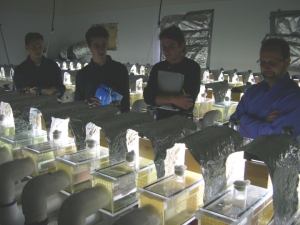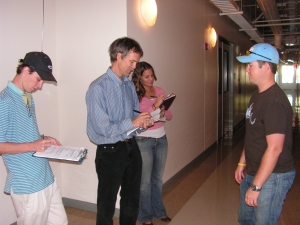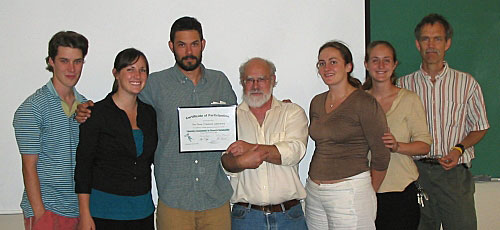The LabSYNC program is driven by the need for conservation in a laboratory setting. Laboratories are central to the discovery missions of universities, but are also the largest users of energy and resources. While many scientists are aware and supportive of the goals of the sustainability movement, it is not normally their primary concern. Through the LabSYNC program, we aim to educate researchers on how to bring sustainability into the lab as well as to provide resources for implementation.

LabSYNC receives a tour of Cardinale Lab from Professor Cardinale. In this stage, LabSYNC learns about the labs' equipment needs.
LARS Program
We have assessed almost 30 labs at UCSB in a wide variety of departments since our pilot program began in the summer of 2006. In each of those labs, we have provided services ranging from saving thousands of gallons of fresh water every year to implementing refrigerator exchanges to save energy and space. Even in the most well-run labs, there always seems to be something that is not working the way it should. Often, lab occupants have made repeated attempts to contact someone to fix the problem without success. Through our work on both the operations and research side of the university, we have been able to connect lab occupants with the appropriate people in Facilities Management to get the problem fixed in a timely fashion.

LabRATS representatives interviewing lab manager Colin Ebert of the Chris Still laboratory. In this step of the process, LabRATS asks behavior based questions to determine how sustainable the lab operations are.
LabSYNC
We have found that, in the few days that the LabSYNC team has to tour the lab and take measurements, it is impossible to see everything that goes on. For this reason, the LabSYNC team meets with the entire lab to formally present our findings over cookies and coffee. At the end of the presentation, we open the floor to lab occupants so they can voice their opinions on the process as well as any ideas they have for implementing sustainability in their labs. In many instances, lab occupants will come up with their own ideas of how they can conserve resources, from new recycling practices to alternate chemical processes that conserve resources.
